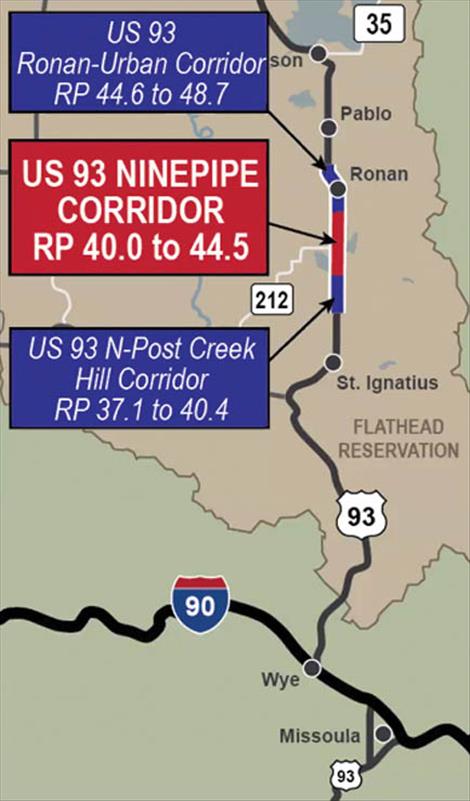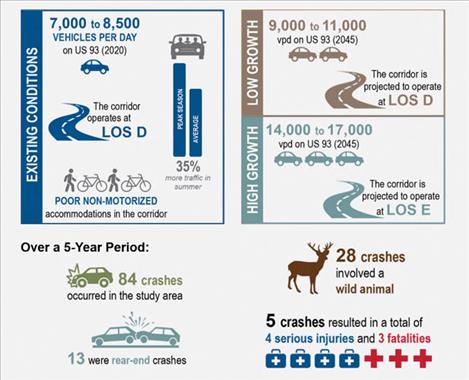Initial findings of Ninepipe corridor feasibility study shared
Hey savvy news reader! Thanks for choosing local.
You are now reading
3 of 3 free articles.
LAKE COUNTY — Improvements to a crucial stretch of U.S. Highway 93 near the Ninepipe Reservoir are being revisited as engineers compare past and current studies on the heavily traveled roadway.
An informational meeting was held on Feb. 7 by the Montana Department of Transportation (MDT) and consulting firm Robert Peccia and Associates (RPA) to share the initial findings in the feasibility of improving the Ninepipe corridor.
Improvements to the Ninepipe corridor, between Post Creek Hill and Ronan, have been in discussion for an extended period with planning efforts reaching back as far as 1996, according to MDT preconstruction engineer Jacquelyn Smith. In 2008, a supplemental report was created to determine design details, which was used for reference in the 2022 meeting.
A range of corridor alternatives were considered in 2008, the preferred being a two-lane road with widened shoulders and a designated bicycle path.
Several factors and potential constraints must be considered when expanding upon the design, explained Smith, including constructability, impact, and cost. One such example is the groundwater challenges which are impeding the design of a bridge in the Post Creek Hill area.
To determine if the preferred alternative still makes sense for the corridor since the original analysis, a new inspection of relevant conditions was completed in late 2021. This includes the study of current traffic and safety conditions, as well as environmental and cultural impacts.
According to Scott Randall, RPA Consultant Project Manager, the investigation shows traffic volumes now range from around 7,000 to 8,500 vehicles per day and are continuing to grow along the corridor. Presently, the corridor experiences a service level grade of D, two grades above failing, meaning drivers are more likely to experience potentially dangerous traffic conditions. Continued service growth could result in a drop to level of service grade E. There was also found to be a lack of adequate accommodations for non-motorized users.
Accident reports in the last five years reveal there have been 84 total crashes during this period along the corridor, approximately 17 per year. About one third of these crashes, 28, involved a wild animal. Thirteen crashes involved rear ends of cars, and 5 crashes resulted in serious injuries or fatalities.
Most of the study area is surrounded by public lands intended for wildlife conservation, though in general MDT does own the minimum desired width proposed for the corridor. The route also passes through floodplains at some points, but the soil samples taken indicate no issues in the soil firmness that would bar construction.
The Ninepipe area supports a large variety of wildlife species and diverse habitats which were included in the evaluation in coordination with resource agencies. Animal injury and loss of life in vehicle encounters, as well as ideal locations for animal crossings that can accommodate a variety of species were included in the study. MDT is coordinating with the tribes and other federal and local resource agencies to discuss how corridor improvements could impact wildlife.
Lastly, the team evaluated culturally significant features and sites within the corridor to understand how they may be impacted by potential changes. The 2008 study identified three cultural resources present: a Flathead Indian irrigation project, a historical stagecoach route, and a Ninepipe traditional cultural property. Randall stated that MDT is in the process of conducting government to government consultation with the tribes regarding the cultural resources and are in ongoing discussions.
In terms of next steps, RPA transportation engineer Sarah Nicolai said the above findings will be applied to the feasibility study and compared to the 2008 preferred alternative to define approximate construction limits. The comparison will also help to define project impacts and costs.
Once the study was explained, the meeting was opened for questions. One attendee asked about the estimated budget for the project and if it would qualify for recent federal infrastructure support. Smith replied that without all the design details present, there is no accurate cost estimate available at this time. However, once the design project is further along it will be eligible for federal aid.
Another attendee inquired if any advocacy groups were working with MDT to help prioritize the project, to which Smith answered they are presently in the data gathering point of the project but would be open to working with advocacy groups in the future. They are working with adjacent landowners and the CSKT and are putting together a contact list for future outreach.
One of the final questions pointed out that the preferred (two-lane) alternative was proposed 14 years ago and if a four-lane proposal would be considered instead. Nicolai said that MDT is using the 2008 study as a starting point and will be reevaluating present needs. She added that sensitive area resources that caused the two-lane determination back in 2008 will have to be balanced in consideration with other limiting factors.
“If we were just looking into traffic volumes alone, it does look like we’re in need of some expansion. We understand that’s a major concern,” said Randall. “If we were looking at it in a vacuum that’s one thing, but the reality is there’s a lot more challenges we’re faced with that we have to consider as well.”
The meeting was recorded and is available on the MDT website along with an option to submit public comment. The next public outreach meeting for this project will occur in late spring or early summer.

















